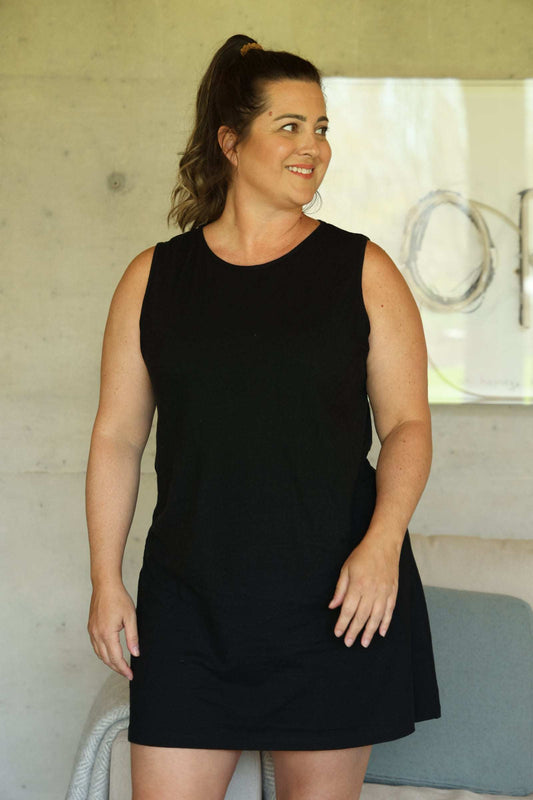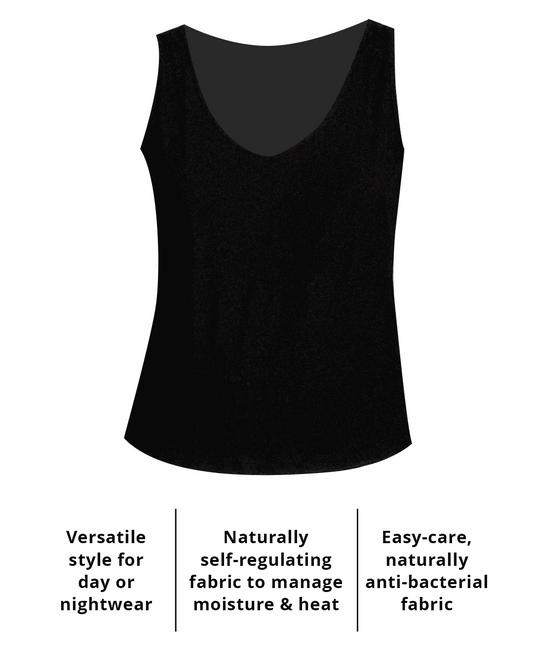
The Best Fabric For Night Sweats Sufferers and the Planet
Partager
When I set out to make our moisture-wicking, heat-managing sleepwear for night sweats, I was intent on finding the best fabric for night sweats and the planet. That meant, I would only look at plant and animal derived fabrics.
The criteria were that it had to be:
- highly responsive to heat and moisture given off by the body,
- able to absorb and release heat, while wicking moisture away as soon as it appeared on the skin
- long-lasting and able to hold up over several washes
- easy to care for - definitely no hand-washing and dryer-ready
- naturally anti-bacterial
- comfortable to wear every night for as long as night sweats lasted
If a fabric could do all these things, the night sweats sufferer would have a fighting chance at sleeping dry, more comfortably, waking up less often to toss of covers, and wake up dry and refershed in the morning.
Summary of The Best Fabric for Night Sweats and the Planet:
We chose hemp blended with organic cotton after a long look at all the benefits of its natural properties. But it’s also got a great – as in low – environmental footprint versus other crops. Industrial hemp is used to make everything from building materials, fabric, and paper to animal feed, and food (hemp hearts) and oil.
Hemp’s natural structure gives it great properties to address a body’s heat and moisture. A little more detail about hemp:
- The bast fibres from inside layers of the stalk, are used to make fabric,
- Due to their porous walls and hollow cores, they act as capillaries to quickly wick heat and moisture away from the heat source,
- Some heat is stored in the fibres’ hollow core and released as your body cools,
- Moisture is wicked away from the skin keeping you dry,
- Anti-microbial properties stop it from absorbing body odour after a night of sweating,
- It is also UV resistant (really important in a nightgown!…kidding)
Simple is better
Nature did an amazing job creating hemp, so why go looking for high-tech, energy-consuming, synthetic fabrics to do the same job? Hemp has been around for centuries. It's durable so garments last a long time and need replacing less often, and most importantly, it's extremely effective at managing heat and moisture. We think hemp is an awesome material for moisture-wicking, heat managing apparel.
The Best Moisture-Wicking, Heat-Managing, Sustainable Fabric
Hemp is a great fabric for so many reasons, some related to its natural heat and moisture properties and some for other beneficial reasons.
Hemp fabric is still not that common. One of the reasons it’s not well-known, or its benefits understood, is due to its link to cannabis- marijuana, its cousin – well, more like its distant sibling. They are basically the same plant – but hemp contains a maximum of 0.3% THC (tetrahydrocannabinol, the psychoactive drug and the reason the plant is regulated) versus marijuana, for which the amount of THC it contains is not restricted. Health Canada still requires farmers to get a special license to grow hemp, and it must be renewed annually.
If you are familiar with hemp it might be in a digestible form – hemp hearts are very popular due to their high protein and omega 3 and 6 content. CBD (cannabidiol) oil is also popular for its anti-inflammatory properties. It can be either extracted from hemp or marijuana plants.
But hemp has many other uses outside of food. The stalks are great as feedstock for everything from paper and building materials (hempcrete and insulation), to fabric.
If the fabric is produced responsibly, it has a low environmental impact, and retains all the properties of the hemp stalk. We use a hemp fabric from hemp that is grown and manufactured responsibly so you can rest easy knowing your nightgown is made from ethically-produced fabric.
A brief look at the hemp plant’s unique structure and properties
Growth: Industrial hemp – which is the variety of hemp used for making fabric, paper, hempcrete, and insulation (among other things) – can grow between 10 and 15 feet tall, needs only rainwater (no irrigation necessary), and needs little pesticides or herbicides because it is densely planted and grows quickly. It takes 1/3 the land and less than half the water to produce 1 pound of hemp fibre versus 1 pound of cotton fibre.
In warm climates you can cultivate up to 3 crops per year as a growing cycle is 4 months. In Canada and the northern US, you usually only get one crop per year. Its deep long tap root does well in rich, loamy soils and can replenish soils with nutrients and moisture. It’s also been known to clean soil, taking away heavy metals from polluted soils.
Hemp plant: The hemp plant consists of stalk, leaves, and buds which turn into flowers. The stalk consists of the epidermis, bast and hurd – the inner and outer cores of the stalk. Fabric is made from the bast fibres – the very strong part of the plant. The bast layer is made of cellulosic microfilaments which are very porous while the internal part of the fibre is hollow - think of a straw with a ton of holes through its wall.
When moisture and heat are next to the fibres, natural capillary action takes over: the moisture and heat are drawn away from the source via the pores and into the central hollow core. The moisture and heat naturally travel through it towards drier areas where it can evaporate. The heat is stored in the hollow core until it's needed again.
How does hemp fabric help with hot flashes and night sweats?
When you’re having a hot flash, the heat and sweat given off by your body is drawn away by the hemp fibre via the porous fibre where the moisture evaporates into the air while the heat is stored in the fibres and is released to you as your body temperature drops again after the hot flash is over. This action keeps you more comfortable while your body’s temperature fluctuates. The peaks and valleys of a night sweat/hot flash become less severe, more even. You can sleep better, less disturbed by your body's actions. Less cover-flipping and waking up, more sleep.
Hemp is considered 4 times more absorbent than cotton but has the added benefit of being able to release the moisture much faster than cotton so the fabric stays drier next to your skin.
Hemp fabric also has a few other great qualities in addition to its superior heat and moisture management properties.
- It’s anti-bacterial, so, in the case of our nightgown, it stays fresher, longer and you won’t have to wash it every day.
- The fibers are very strong which means hemp clothing tends to last a long time. It also softens over time, so the more you wear it, the softer it gets.
- Finally – and this is really important for nightgowns – hemp is UV resistant, so you won’t get a sunburn while wearing it. ;)
Another reason why we like hemp for our products is that it’s a crop we grow right here in Canada. While most of it is slated for food use, some of it goes for building materials, paper, and absorbent products (made from the hurd – the inside part of the stalk).
Although hemp textiles aren’t made in North America, it’s possible that one day they will be (I can’t dream, can’t I?), and when that happens, you can be sure we’ll be looking at them for our products.
All in all, hemp is an underestimated, misunderstood crop. It’s good for the earth and good for humans. We should be promoting it and demanding products be made from hemp for all the right reasons.
You might also like:





